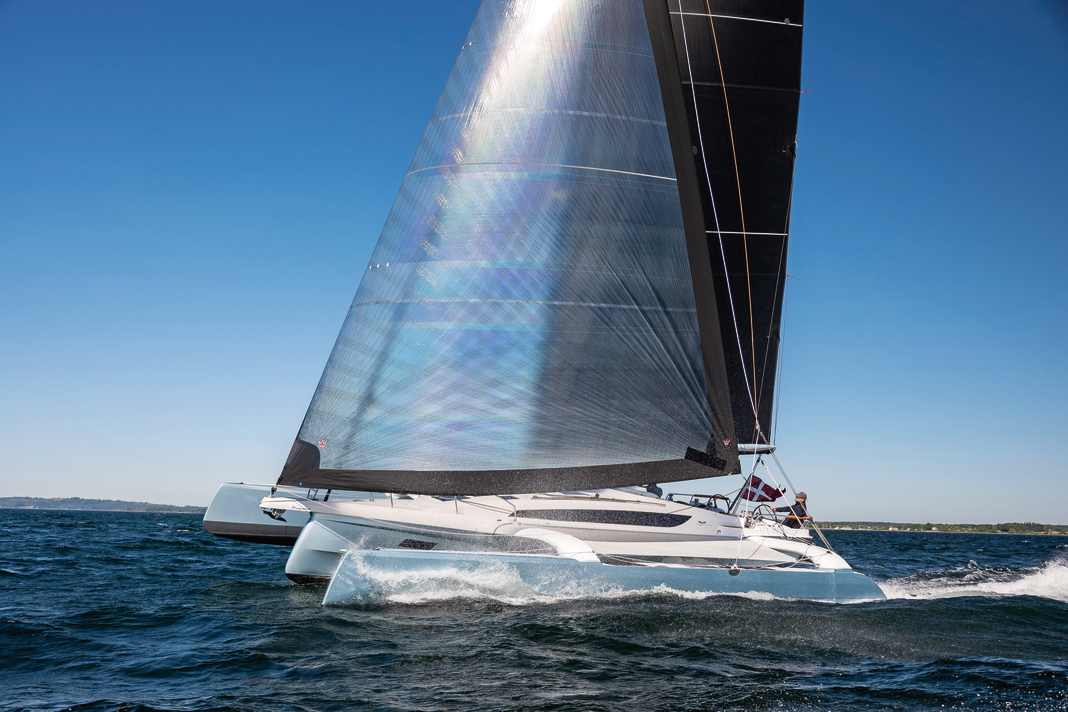In the fast lane: Impressions from the test of the blazingly fast Dragonfly 36
Hauke Schmidt
· 04.06.2025






Hardly any test is as popular with the editors as that of a new tri from Quorning Boats. This is because Dragonflys promise enormous sailing fun, easy handling and solid workmanship. What's more, the boatyard is an extremely friendly family business whose owner and boss does not focus on the profits of his companies, but is a boat builder and thoroughbred trimaran sailor. The expectations for the new 36-foot model, which the shipyard unveiled in the middle of last year and presented at boot in Düsseldorf, were correspondingly high.
The Dragonfly delivered - at the end of our two-day test, the top speed was 21.6 knots in around 19 knots of wind. This means that the 36 even surpasses the top value of the 40-foot top modelwhich we had tested under comparable conditions.
Officially, the shipyard forecasts a maximum speed of 23 knots, which would make the 36 one knot slower than the 40 Dragonfly. In view of the ease with which the 36 was able to pass the 20-knot mark in the test, it is reasonable to suspect that the forecast is rather conservative and that the 36 has at least the same speed potential as its big brother. One reason for this could be the further developed floats. In contrast to the 40, they are asymmetrical and have a flat underwater hull. This design is common in current regatta tris and ensures better water drainage and less resistance. "We assume that we will produce the 36 in larger numbers than the 40, so we wanted to be able to laminate two floats at the same time and built double moulds. This meant that asymmetrical hulls were no longer a problem," says shipyard manager Jens Quorning.
Fast or hot, the Dragonfly 36 comes in two versions
The test boat is the performance version, which was also shown in Düsseldorf. The standard Dragonfly 36 comes as a touring version. Both versions have a carbon mast, but they differ in their sail configurations.
Touring version
The touring version is ideal for sailors who value easy handling. It has a 16.50 metre long mast.
Performance version
If you want more action, the Performance version comes with a two metre higher mast and a larger overlapping furling genoa as well as significantly more sail area overall. The Code Zero increases by around 12 square metres. The gennaker even grows by 20 square metres and the performance mainsail of the Dragonfly has a gigantic 73 square metres, mind you on a 36-foot boat. In this version, the mainsail alone has more cloth than an average cruising yacht brings to the wind. The construction of the hulls and the weights of both versions are identical.
Price question
The touring variant is offered at a base price of 627,130 euros including VAT. The sharper performance model costs at least 656,260 euros. This makes the Dragonfly 36 significantly more expensive than a comparably sized monohull. However, the standard boat also comes with a range of equipment that is usually at extra cost, such as four electric winches and the carbon rig. In addition, the forces that occur in fast trimarans require significantly more complex laminates and very careful production, which means that the prices are hardly comparable with monohull yachts and certainly not with mass-produced products.
Technical data of the Dragonfly 36
| Design engineer | Olsen Design / Quorning Boats ApS |
| Hull length | 11,55 m |
| Width | 8,12 m |
| Width with retracted floats: | 3,70 m |
| Draughts | 0.67 m - 2.00 m |
| Weight ready to sail | 4,5 t |
| Mast height | 16.5 m (touring) /18.50 (performance) |
| Mainsail | 61,0/73,0 m2 |
| Genoa | 32,5/37,0 m2 |
| Self-tacking jib | 29,0/30,0 m2 |
| Gennaker | 125/145 m2 |
| Code Zero | 55/67 m2 |
| Engine | 30 hp / 21.3 kW |
Further tri-themes:
- Cruising in Denmark with the Dragonfly 28
- Cape-WT40: Light trailer tri from England
- Rapido 40: Lightweight trimaran from Vietnam. The test
- Dragonfly 40: The full test report at YACHT online
- Corsair 760: Attractive folding runner on the test bench
- Playground on the water: testing the Astus 22.5
- Carbon rocket: Black Marlin
